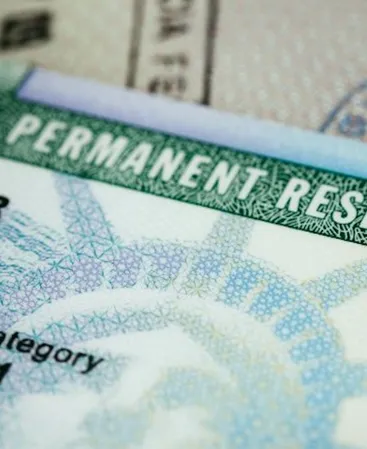MON – FRI (8am - 6pm)
The E2 Visa to Green Card process allows foreign nationals from treaty countries to transition from temporary status to permanent residency. Investors can use the E2 visa to establish or purchase a U.S. business, provided they make a substantial investment that actively supports the U.S. economy.
The E2 visa supports family members, allowing spouses to work and children under 21 to study in the U.S. These benefits foster cross-border investments and strengthen U.S. economic ties. Contact Serving Immigrants for all your legal immigration needs.

Transitioning from an E2 visa to a Green Card requires selecting the right category (e.g., employment, family, or investment) and filing a petition with USCIS. Approved petitions allow applicants to adjust status in the U.S. or process abroad, completing biometrics, background checks, and an interview to secure permanent residency.
Understanding the distinction between non-immigrant visas like the E2 and immigrant visas is essential. Non-immigrant visas are temporary, requiring proof of intent to leave the U.S., while immigrant visas lead directly to permanent residency.
Green Card holders enjoy unrestricted work, public services, and international travel. Transitioning from a non-immigrant visa requires strict legal compliance to ensure residency.

Employment-based Green Cards provide a pathway for E2 visa holders. EB2 requires exceptional ability or advanced degrees, while EB-3 needs basic job qualifications, both requiring employer sponsorship.
The employer starts by obtaining labor certification to confirm no U.S. workers are available, then files Form I-140 with USCIS. While processing times vary, employment-based Green Cards offer a clear path to permanent residency.
Labor certification (PERM) is essential for employment-based Green Cards, requiring employers to prove hiring a foreign worker won’t harm U.S. labor conditions through job ads, recruitment efforts, and wage proof.
For E2 visa holders, aligning qualifications with U.S. labor market needs is crucial. Employers favor candidates filling skill gaps, and immigration attorneys help ensure legal compliance.
Family sponsorship is a straightforward path to residency for E2 visa holders. U.S. citizen spouses can file Form I-130, with no annual visa limits, ensuring shorter wait times.
Children of E2 visa holders born in the U.S. automatically gain citizenship and can sponsor their parents at 21, offering families a secure path to long-term residency.
Family-based applications need solid proof of the applicant-sponsor relationship. Spousal sponsorship requires USCIS to verify marriage legitimacy through affidavits, photos, and financial evidence.
Once Form I-130 is approved, applicants can file Form I-485 to adjust status in the U.S. or complete processing abroad. Both options lead to a Green Card, granting permanent residency and benefits. See how Form I-485 looks.
The EB-5 Investor Program provides E2 visa holders a direct path to a Green Card through financial and job creation requirements, with lower thresholds in rural or high-unemployment areas.
E2 visa holders can leverage their existing business for EB5 by expanding operations, increasing investments, and documenting job creation. Strategic planning with immigration attorneys boosts compliance and approval chances.
The E2 visa allows indefinite business operation in the U.S. but doesn’t lead to residency. In contrast, EB5 provides a direct path to a Green Card with stricter requirements.
E2 visa holders can transition to EB5 by leveraging their existing business but must track investment sources and meet job creation rules. Need legal solutions? Contact Serving Immigrants to guide you through the process.

The E2 Visa to Green Card process offers entrepreneurs and investors flexibility, including indefinite visa renewals if their business stays operational. Unlike employment-based visas, the E2 visa provides significant control over business decisions, enabling innovation and growth.
This is particularly advantageous for those aiming to establish long-term ventures in the competitive U.S. market.
The E2 visa allows spouses to work and children to study, easing family integration. For those pursuing the E2 Visa to Green Card, it serves as a foundation for pathways like EB5 or family sponsorship. An immigration attorney can provide critical assistance.
Keeping your E2 visa status valid is crucial while awaiting Green Card approval. This guarantees that you can remain in the U.S. legally without interruptions during the process.
By consulting an experienced immigration attorney, you can align your current visa obligations with your long-term residency goals without jeopardizing your status.
Proactive planning ensures continuous legal status in the U.S., even if Green Card processing takes longer than anticipated.
Transitioning from an E2 visa poses challenges due to its temporary nature. Holders must prove intent to leave the U.S., creating uncertainty for those planning long-term stays. Unlike Green Cards, the E2 visa does not directly lead to permanent residency.
Dependents aging out at 21 can disrupt family dynamics, requiring them to obtain independent visas. E2 visa holders are also limited to their business, which reduces career flexibility.
Strategic planning is crucial for navigating the E2 Visa to Green Card process. Exploring pathways like employer sponsorship, EB5, or family-based options early can mitigate risks.
A tailored approach aligned with business goals and family needs is key to transitioning to a Green Card. Expanding a business to meet EB5 criteria or securing employer sponsorship are effective strategies, especially when leveraging expert guidance.

This FAQ section answers commonly asked questions about the process and requirements for transitioning from an E2 Visa to Green Card:
No, the E2 visa does not provide a direct path to a Green Card. However, E2 visa holders can transition through other eligible categories like EB5, family-based sponsorship, or employer sponsorship.
The timeline varies depending on the pathway. For example, the EB-5 program may take 2–3 years, while family-based sponsorship timelines depend on the relationship and visa availability. You can check your Case Status by clicking here
Yes, your E2 business can serve as a foundation for EB5 eligibility by meeting investment and job creation requirements.
Yes, if eligible, E2 visa holders can file Form I-485 to adjust status while remaining in the U.S., avoiding the need for consular processing abroad.
Investment requirements depend on the pathway. For EB5, a substantial investment and job creation are required, while other pathways may not involve financial criteria.